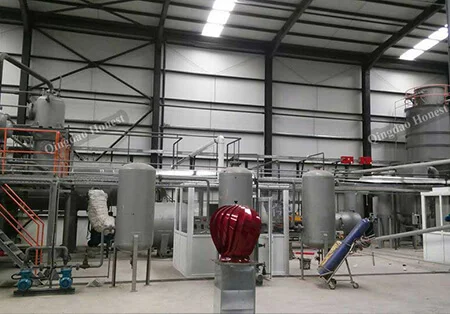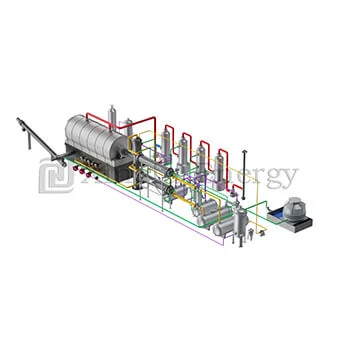Pyrolysis is a heat-based process. It breaks down organic materials at high temperatures. No oxygen is present. This method turns complex molecules into simpler ones. It produces useful by-products. These include oil, gas, and carbon black. The process helps manage waste. It converts tires and plastics into reusable resources. Qingdao Xingfu Energy Equipment Co., Ltd. offers advanced solutions. Their Pyrolysis Plant and Oil Distillation Equipment lead in tire pyrolysis technology.
Tire pyrolysis tackles waste buildup. Used tires and plastics don’t break down easily. Pyrolysis recycles them effectively. It reduces landfill use. It also cuts pollution. The process turns waste into fuel oil and carbon black. The fuel oil powers diesel motors, furnaces, and industrial systems. It has high power and low rotation rates. Pyrolysis saves natural resources. It provides alternative energy and materials.
A pyrolysis reactor is the heart of tire recycling. It works in controlled settings. It thermally breaks down tires without oxygen. This ensures efficient results. The reactor handles whole or broken tires. No pre-cutting is needed. This lowers costs. Advanced cooling systems boost oil recovery. They also reduce emissions.
Using a pyrolysis reactor offers many benefits:
High Efficiency: Modern reactors are simple to run. They need only 2–3 workers for the whole system.
Environmental Benefits: Airtight high-temperature feed systems stop dust. They keep the process green.
Cost-Effectiveness: Hot air heating and heat recycling designs save money.
Safety: Fully automatic welding ensures safe operation.
Airtight feeding saves heating time. It cuts temperature loss. These traits make the pyrolysis reactor essential for waste management.
Tyre recycling plants bring big gains:
Environmental Impact: They keep tires out of landfills. This lowers soil and water pollution from tire leaks. They cut greenhouse gas emissions. Waste becomes cleaner energy.
Economic Opportunities: Products like fuel oil, carbon black, steel wire, and syngas have value. Fuel oil yields 40–45%. Carbon black yields 32–36%. Steel wire gives 14–16%. Syngas provides 5–8%. These create income and jobs.

Tyre recycling plants run smoothly with smart tech:
Integrated Design: Plants don’t need precast foundations. This simplifies setup.
Energy Optimization: Multilevel cooling increases fuel oil output. Heat recycling lowers energy use.
Continuous Production: Automation keeps materials flowing. It cuts downtime.
Environmental Compliance: Dust removal systems ensure clean air during discharge.
Pulse dust removal stops emissions. These features help tyre recycling plants meet green goals. They also boost profits.
Tire pyrolysis solves waste issues. Millions of tires are thrown out yearly. They don’t biodegrade easily. Landfills struggle with them. Pyrolysis breaks tires down with heat. No oxygen is used. It creates fuel oil, carbon black, and steel wire. This cuts landfill reliance. It reduces pollution from tire leaks. Tyre recycling plants lower contamination risks. They protect soil and water.
The green impact is huge. Tire pyrolysis shrinks waste’s footprint. It supports a circular economy. It offers new energy and material sources. This saves natural resources.
Tire pyrolysis yields valuable items:
Fuel Oil: This makes up 40–45% of output. It fuels diesel motors, furnaces, and industrial systems. It’s highly versatile.
Carbon Black: This forms 32–36%. It’s used in rubber, plastics, and inks.
Steel Wire: This is 14–16%. It comes from tire beads. It’s fully recyclable.
Syngas: This is 5–8%. It powers the pyrolysis plant itself.
These products add economic value. They reduce reliance on raw materials.
Tire pyrolysis has hurdles for big projects:
High Initial Costs: Tyre recycling plants need large investments. Advanced machines and regulations drive costs.
Operational Efficiency: Steady performance needs skilled workers. Regular upkeep is key.
Environmental Concerns: Pyrolysis cuts emissions compared to older methods. But poor handling or old tech can pollute air.
Solutions are emerging. Fully automated systems improve efficiency. They cut labor costs. Modern reactors need only 2–3 workers. Strict rules ensure green standards are met.
New tech drives tire pyrolysis forward:
Better Reactor Designs: Enhanced cooling boosts oil recovery. It cuts emissions. Multilevel cooling gets more fuel oil.
Energy Optimization: Heat recycling lowers costs. It uses excess heat from the process.
Automation: Automated systems ensure steady production. They need little human input.
Environmental Compliance: Airtight feeding stops dust. It keeps operations clean.
These advances make tyre recycling plants more efficient. They also make tire pyrolysis greener and cheaper. Qingdao Xingfu Energy Equipment Co., Ltd produces various professional types of tire pyrolysis equipment, and its advanced technology will certainly make you feel the value of money.

A pyrolysis reactor thermally breaks down materials like tires. It works without oxygen. It produces fuel oil, carbon black, steel wire, and syngas.
Tire pyrolysis cuts landfill use. It turns non-biodegradable waste into fuel oil and carbon black. It reduces pollution.
Tire pyrolysis gives fuel oil (40–45%), carbon black (32–36%), steel wire (14–16%), and syngas (5–8%). All have industrial uses.
Yes, high costs, efficiency needs, and green compliance are issues.
For more information on advanced tire recycling solutions or to explore Qingdao Xingfu Energy Equipment Co., Ltd.’s offerings located at Qingdao city since 2010 specializing in innovative waste management systems, feel free to contact their team directly!